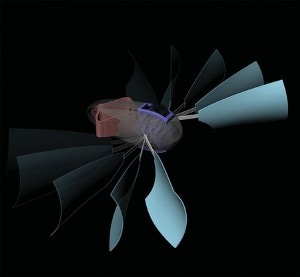May 22 2018
Robots that paddle through water without using any power supply, servos, or motors have been developed by a team of engineers at Caltech and ETH Zurich. These first-of-their-kind devices are capable of self-propulsion because the material which is used to construct them deforms with changes in temperature.
 An artist's rendering of the new design for a robot that uses material deformation to propel itself through water. (Image credit: Tian Chen and Osama R. Bilal)
An artist's rendering of the new design for a robot that uses material deformation to propel itself through water. (Image credit: Tian Chen and Osama R. Bilal)
With this latest study, the boundary between robots and materials seems to be blurred. The material itself makes the machine to operate in these self-propelled devices.
"Our examples show that we can use structured materials that deform in response to environmental cues, to control and propel robots," says Daraio, professor of mechanical engineering and applied physics in Caltech's Division of Engineering and Applied Science, and also a corresponding author of a paper revealing the robots that was featured in the Proceedings of the National Academy of Sciences on May 15.
The novel propulsion system depends on strips of an elastic polymer that stretches out when warm and curls when cold. A switch located inside the robot's body is activated by positioning the polymer, and the robot's body is in turn connected to a paddle that rows it forward similar to a rowboat.
A bistable element - a component that can remain stable in two separate geometries - is used to fabricate the switch. In this situation, the switch is constructed from strips of a flexible material that snaps from one place to another when pushed on by the polymer.
Upon placing the cold robot in warm water, the polymer expands, triggers the switch, and the sudden release of energy, which thus occurs, thrusts the robot forward. It is also possible to “tune” the polymer strips to provide particular responses at different times, i.e., when compared to a thinner strip, a thicker strip will take a longer time to warm up, expand, and eventually activate its paddle. It is this tunability that enables the researchers to build robots that are capable of moving and turning at varying speeds.
The study builds on earlier work done by Daraio and Dennis Kochmann, professor of aerospace at Caltech. The team transmitted signals and developed computer-like logic gates using chains of bistable elements.
In the new design iteration, both the team and collaborators of Daraio successfully connected the switches and polymer elements such that a four-paddled robot was able to push itself forward, drop off a tiny payload (in this situation, a token with a Caltech seal inscribed on it), and subsequently paddle backward.
"Combining simple motions together, we were able to embed programming into the material to carry out a sequence of complex behaviors," says Osama R. Bilal, Caltech postdoctoral scholar and co-first author of the PNAS paper. Additional responsivities and functionalities can be added in the future, for instance, utilizing polymers that react to other environmental cues, like salinity or pH. According to researchers, future models of the robots can possibly deliver drugs on a smaller scale, or contain chemical spills.
At present, when the bistable elements snap and discharge their energy, they can be made to work again through a manual reset. The team is next planning to investigate ways to redevelop the bistable elements so that they can reset on their own when water temperature changes again—thus rendering them to swim continuously, so long as the temperature of water keeps changing.
The PNAS paper is titled "Harnessing bistability for directional propulsion of soft, untethered robots." Bilal and Daraio teamed up with Kristina Shea and Tian Chen ETH in Zurich. The Army Research Office and an ETH postdoctoral fellowship to Bilal supported the study.
Motorless Self-Propelled Robots